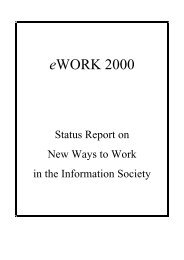Proceedings of 8th European Assembly on telework (Telework2001)
Proceedings of 8th European Assembly on telework (Telework2001)
Proceedings of 8th European Assembly on telework (Telework2001)
Create successful ePaper yourself
Turn your PDF publications into a flip-book with our unique Google optimized e-Paper software.
153The possibility to access an organisati<strong>on</strong>’s available database and files is a further elementthat should characterise a genuine knowledge management, although nowadays the access andbrowsing, due to the tools heaviness and c<strong>on</strong>tents wideness, sometimes are prohibitive. Thismethodology, that allows simple (not simplistic) search and browsing, is based <strong>on</strong> appropriatetechnological choices, but actually deriving from the old approach <str<strong>on</strong>g>of</str<strong>on</strong>g> the 70s mainframes’ world.The knowledge browsing tools are generally designed to provide the ‘right’ answer, but are notdesigned to c<strong>on</strong>sider experience. Also here it is supposed that the user encodes what he/she wantsto possibly receive the ‘right’ answer 19 .Tools that give us the right answer <strong>on</strong>ce we have defined the problem are not useful, or at least are<strong>on</strong>ly scarcely useful. What we need are tools that help us to define a problem, tools that allow usto communicate and browse am<strong>on</strong>g files in order to help us defining what we need and what canbe imagined and carried out.The comp<strong>on</strong>ents <str<strong>on</strong>g>of</str<strong>on</strong>g> an actual knowledge management system can therefore be given as a platformfor cooperati<strong>on</strong> and horiz<strong>on</strong>tal communicati<strong>on</strong>, a workflow system and a search and browsingengine based <strong>on</strong> methods that are appropriate to interpret c<strong>on</strong>tents. We want to repeat againthat these are <strong>on</strong>ly the technological systems, while a knowledge management systems must bedeveloped <strong>on</strong> the organisati<strong>on</strong>al texture itself, by introducing organisati<strong>on</strong>al models very far fromthe hierarchical paradigms. In other words, knowledge and innovati<strong>on</strong> are embodied experiencesand the human beings are those who can make them true.The point <str<strong>on</strong>g>of</str<strong>on</strong>g> view to look from is that <str<strong>on</strong>g>of</str<strong>on</strong>g> the observer, who has the role <str<strong>on</strong>g>of</str<strong>on</strong>g> interpreting the signs.The interpretati<strong>on</strong> is the generati<strong>on</strong> <str<strong>on</strong>g>of</str<strong>on</strong>g> meanings, starting from the experiencing <str<strong>on</strong>g>of</str<strong>on</strong>g> the object wewant to know and carrying through <strong>on</strong>e’s knowledge capacity, <strong>on</strong>e’s living organisati<strong>on</strong>.However, things seems to have taken rather a different route: from many sided we hear abouts<str<strong>on</strong>g>of</str<strong>on</strong>g>tware tools for knowledge management as if it were accountancy; or we hear speeches aboutstock management <str<strong>on</strong>g>of</str<strong>on</strong>g> bits <str<strong>on</strong>g>of</str<strong>on</strong>g> knowledge, as if this could be written <strong>on</strong> a hard-disk and transferredregardless the subject that created it in the experience phase 20 .As a matter <str<strong>on</strong>g>of</str<strong>on</strong>g> fact these interpretati<strong>on</strong>s produce technological and organisati<strong>on</strong>al involuti<strong>on</strong>,because they inhibit the development <str<strong>on</strong>g>of</str<strong>on</strong>g> the organisati<strong>on</strong> showing how much unreas<strong>on</strong>able andharmful in terms <str<strong>on</strong>g>of</str<strong>on</strong>g> efficacy they are. Any tool that encapsulate informati<strong>on</strong> and re-proposes itas knowledge, tends to give an idea <str<strong>on</strong>g>of</str<strong>on</strong>g> knowledge as something that homologates us all the sameand leaves outside all that, <strong>on</strong> the c<strong>on</strong>trary, distinguishes the individualities and the cooperati<strong>on</strong>networks 21 .We want to be nasty: sometimes knowledge management seems to work hard to the further dulling<str<strong>on</strong>g>of</str<strong>on</strong>g> organisati<strong>on</strong>s.«… if our desires do not change, nothing changes in fact because we go <strong>on</strong> living through it thesame c<strong>on</strong>fi gurati<strong>on</strong> <str<strong>on</strong>g>of</str<strong>on</strong>g> acti<strong>on</strong> (<str<strong>on</strong>g>of</str<strong>on</strong>g> emoti<strong>on</strong>ing) that we used to live.» 2219 Generically it resolves into a list <str<strong>on</strong>g>of</str<strong>on</strong>g> documents organized with a variously generated rating20 Laurence Prusak (IBM), not being a particularly ascetic theorist, also speaks in a similar way.21 Mutually co-defi ned.22 Humberto R. Maturana, «Metadesign», in V.V. A.A., Technomorphica, V2_Organizatie, 1997








